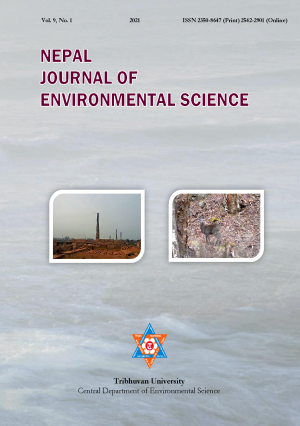Application of activated effective microorganism, mudball and biosand filter for the treatment of dye wastewater
DOI:
https://doi.org/10.3126/njes.v9i1.37376Keywords:
Biosand filter, dye wastewater, effective microorganism, EM mudballsAbstract
A study was carried out to evaluate the application of Activated Effective Microorganisms (AEM) solution and EM Mudballs (mixture of soil, rice bran, and EM) to wastewater generated from wool and cotton dyeing unit at Kumbeshwar Technical School (Lalitpur, Bagmati Province, Nepal). Furthermore, the AEM treated wastewater was treated through a Biosand filter as a final treatment and polishing step before discharge in a nearby sewerage system. The wastewater samples collected for 27 days were analyzed for the wastewater quality parameters such as pH, Electrical Conductivity (EC), Total Solids (TS), and Chemical Oxygen Demand (COD) using the standard methods. The average values of pH, conductivity, COD, and TS after the EM combined with Biosand (final) treatment were observed to be 7.49±1.15, 1.39±0.25 mS/cm, 1,669.4 ±858.14 mg/L, and 264±25.29 mg/L, respectively. TS and COD removal were observed to be 43.97±22.3% and 15.26±10.06%, respectively. The results show that the dye wastewater is difficult to remove by a simple biological process like the addition of EM. Combined EM and biosand filters can be an inexpensive way of treating industrial effluents. However, the existing treatment system needs to be optimized by the integration with the proper EM: water: molasses ratio, optimal feeding time and design, hydraulic retention time, solids retention time, organic loading rates in EM reactor, and COD/BOD ratio in wastewater among other important components to meet the national effluent discharge requirements.
Downloads
Downloads
Published
How to Cite
Issue
Section
License
This license enables reusers to distribute, remix, adapt, and build upon the material in any medium or format for noncommercial purposes only, and only so long as attribution is given to the creator.

